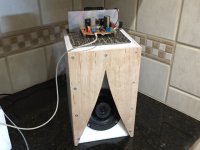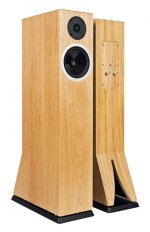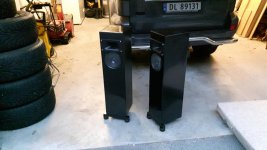a 9 driver k could be fun and even 4 drivers pretty potent. fwiw, I'd like to see some K builds with K-tube either on top or in the front cavity as with Karlson's 'X15"
here's an old kluged 18" two way where I added an extra 20 liter chamber above the vent to smooth response - originally the wings extended all the way to the bottom but I took out 3" from their top to play with a raised aperture. It played well with full height wings.

here's an old kluged 18" two way where I added an extra 20 liter chamber above the vent to smooth response - originally the wings extended all the way to the bottom but I took out 3" from their top to play with a raised aperture. It played well with full height wings.

Class A Daytonator XKi Kitchen Radio
Class A and PA130-8 Daytonator makes it to prime time as the main kitchen radio. 🙂
ACA 5w class A amp with fan heatsink. 3.5mm stereo to mono conversion with two 4.7k resistors tied together.
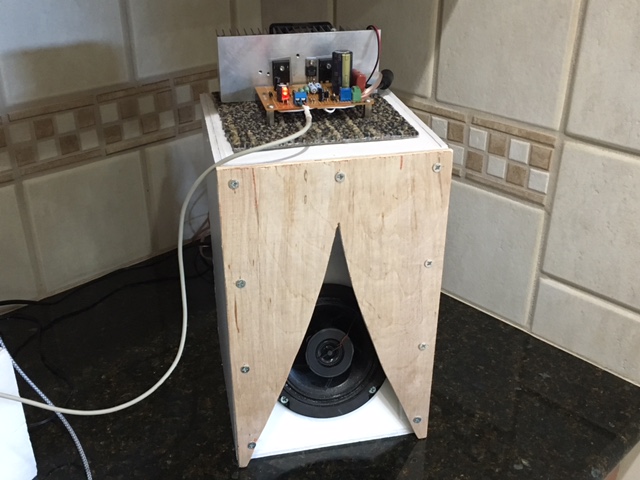
Class A and PA130-8 Daytonator makes it to prime time as the main kitchen radio. 🙂
ACA 5w class A amp with fan heatsink. 3.5mm stereo to mono conversion with two 4.7k resistors tied together.

Attachments
Last edited:
Is that a diy coaxial?
Yes. An experiment that spun off from my attempt to cut the cone, a la Revelator. A fun concept really - not the best measuring coax but sounds fine once behind the K aperture. It's a first order XO so the timing is pretty tight.
http://www.diyaudio.com/forums/full-range/279043-daytonator-pa130-8x-3.html
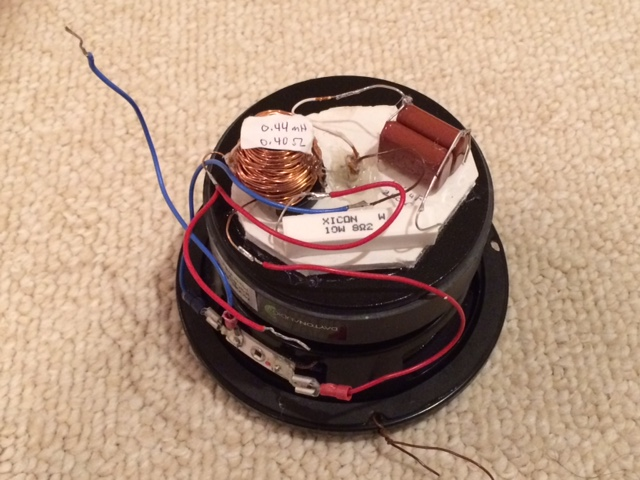
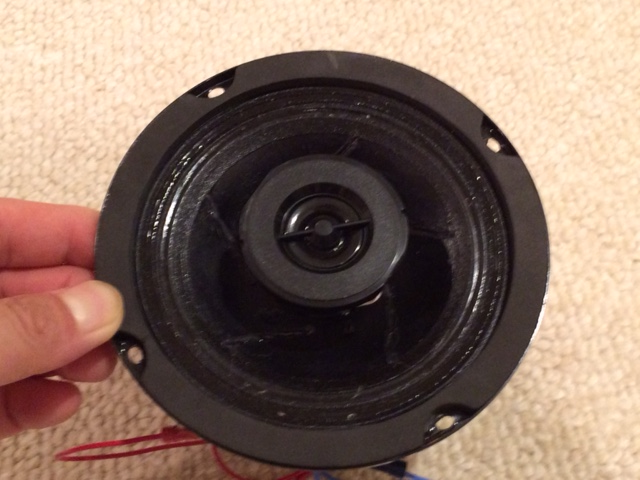
That is a a clever build. I can't hear much above 10 kHz, so probably wouldn't get much benefit. Interesting to see though.
I used to think my ears can't hear above 16k but when I got good tweeters that go out to 22kHz it made a difference. I think the extended bandwidth prevent the natural low pass filter that causes ringing in time space. It does make a difference in dynamics and clarity.
Agree xrk971 on extended bandwidth, at normal listening SPL my hearing also fade 15-16kHz. Have a 10F that run as mid-tweet and normal has roll off around 15-16kHz area with break up modes up higher inside 20-30kHz area. With JRiver as speaker management system running DSP plus DACs at 192kHz have corrected those break up modes on axis and also lifted general HF extension for 10F a bit. Funny thing is that my HF hearing restriction doesn't hinder me to very clear hear when ticking on and off that DSP correction and actual perceive but could be wrong that the better HF extension is some of the quality thing that let one hear into room where track was recorded.
HF response supports the rise times in complex music wave shapes. When I was young and playing around in the lab at work I found that although I could not hear 19kHz I could tell whether the signal gen was off or on. It's hard to define but like a spacey feeling in the head.
X, a neat job on that coax!
X, a neat job on that coax!
Hi XRK,
I'm sorry, this is a little of topic. But what do you make of this design. Is it a BVR or bandpass design? Brian Taylor the designer referred to it as a horn speaker...
A few years back he returned with a speaker called Aspara Acoustics HL6, which I think is modified version of the Impulse H6.
Take a look at the taper, looks familiar 😉
I built a set speakers, inspired by the H6 design, just finished them. I really like the sound of these. No really deep bass, but the bass that is there is tight, tunefull and with surprisingly impact given the size of the woofer.
I'm sorry, this is a little of topic. But what do you make of this design. Is it a BVR or bandpass design? Brian Taylor the designer referred to it as a horn speaker...
A few years back he returned with a speaker called Aspara Acoustics HL6, which I think is modified version of the Impulse H6.
Take a look at the taper, looks familiar 😉
I built a set speakers, inspired by the H6 design, just finished them. I really like the sound of these. No really deep bass, but the bass that is there is tight, tunefull and with surprisingly impact given the size of the woofer.
Attachments
depending upon the gap and perimeter area of the "mouth", if enough, then probably is BVR - like Bastanis "Matterhorn" - have you tried to model it in hornresp?
Hi,
No I'm sorry, I only speak winisd.😀
For some strange reason there has been quite an interest in the Impulse H6 speaker in Norway. There have been built many clones with various woofers, not all of them very successfull, the cabinet is quite sensitive to the woofers parameters.
The original H6 was built using the Seas CA17RCY woofer. Most of the clones have been built using Vifa C17WH/WG variants. But now they have also become almost impossible to get hold of. I have seen several guys (including myself) buying vintage speakers just to pull out the woofers. Dali 104 has to be THE most sold speaker in Norway, and it utilizes a pair of Vifa C17WG in each speaker, so that one is popular to "butcher" for the H6 fans.
No I'm sorry, I only speak winisd.😀
For some strange reason there has been quite an interest in the Impulse H6 speaker in Norway. There have been built many clones with various woofers, not all of them very successfull, the cabinet is quite sensitive to the woofers parameters.
The original H6 was built using the Seas CA17RCY woofer. Most of the clones have been built using Vifa C17WH/WG variants. But now they have also become almost impossible to get hold of. I have seen several guys (including myself) buying vintage speakers just to pull out the woofers. Dali 104 has to be THE most sold speaker in Norway, and it utilizes a pair of Vifa C17WG in each speaker, so that one is popular to "butcher" for the H6 fans.
IMO it's a hybrid TL-horn - not a BVR. Easy enough to model in Akabak and I can see a small resemblance to another very popular back firing folded horn that is out there.
The small K aperture is not going to do much as the length there doesn't affect the bass frequencies enough as they are much longer wavelengths. So really for show. You could just have a rectangle and it would work the same.
The small K aperture is not going to do much as the length there doesn't affect the bass frequencies enough as they are much longer wavelengths. So really for show. You could just have a rectangle and it would work the same.
Ok, thanks XRK!
The original Seas CA17 had a VAS 46l, Qts 0,25 and Fs 37Hz. The Vifa C17 WH Troels Gravesen measured to have VAS 31,1l, Qts 0,34 and Fs 49Hz.
Not easy to find drivers today with similar specs.
Any tip on how to modify the cab to fit a Seas CA18RNX/RLY or any other fairly sensitive midwoofer?
(I know a lot of guys in Norway would be very grateful)
Cbarth
The original Seas CA17 had a VAS 46l, Qts 0,25 and Fs 37Hz. The Vifa C17 WH Troels Gravesen measured to have VAS 31,1l, Qts 0,34 and Fs 49Hz.
Not easy to find drivers today with similar specs.
Any tip on how to modify the cab to fit a Seas CA18RNX/RLY or any other fairly sensitive midwoofer?
(I know a lot of guys in Norway would be very grateful)
Cbarth
I played with my pa130's a few days ago. I put on cedar wings and put foam tape stuff inside the back cover instead of the cork I had in there for a gasket. The change is huge. The 400hz to 1000hz harshness is gone and they sound nice and mellow now. I checked the back panels for leaks before so, not sure why the change is so huge except for the new wings.
I had 1/4" plywood wings before. I roughed a pair of these out and was happy with the change right away.
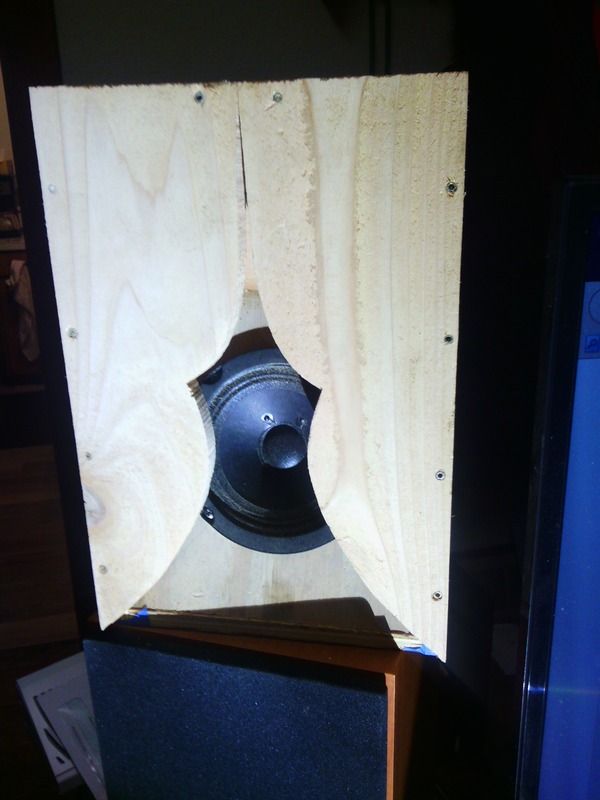
I had 1/4" plywood wings before. I roughed a pair of these out and was happy with the change right away.

that's an interesting aperture - - good you're doing empirical work and evaluation
I've got two "K10" - one about a decade or more older and a 0.62 scaled K15 ready for play. The old one with Delta10A and a P-Audio BM440 compression driver on a metal K-tube can do some cool stuff - the 0.62 scale coupler with newer model Beta10cx - dunno yet - also I may load the 0.62 scale coupler with a Celestion TF1020 - at 2mm xmax, not a lot of air movement but that might go pretty far in little K. I'e like to try the Kappa123a XKi suggested in this thread but am a bit leery of its 50 liter back chamber - guess it could be blocked down with foam if needed - seems like it might lose power handling and PUNCH by trying to go lower than a regular K12 (?)
I've got two "K10" - one about a decade or more older and a 0.62 scaled K15 ready for play. The old one with Delta10A and a P-Audio BM440 compression driver on a metal K-tube can do some cool stuff - the 0.62 scale coupler with newer model Beta10cx - dunno yet - also I may load the 0.62 scale coupler with a Celestion TF1020 - at 2mm xmax, not a lot of air movement but that might go pretty far in little K. I'e like to try the Kappa123a XKi suggested in this thread but am a bit leery of its 50 liter back chamber - guess it could be blocked down with foam if needed - seems like it might lose power handling and PUNCH by trying to go lower than a regular K12 (?)
I played with my pa130's a few days ago. I put on cedar wings and put foam tape stuff inside the back cover instead of the cork I had in there for a gasket. The change is huge. The 400hz to 1000hz harshness is gone and they sound nice and mellow now. I checked the back panels for leaks before so, not sure why the change is so huge except for the new wings.
I had 1/4" plywood wings before. I roughed a pair of these out and was happy with the change right away.

There is a large subjective change in sound by adding padding or stuffing inside the front chamber as this reduces the internal resonances. I usually line the inside of my front chamber with Mr Clean Magic Eraser blocks (aka BASF professional sound abatement foam). Cleaner smoother sound usually results. Stiffening the front aperture with bracing makes a big audible difference too. Line the backside of the aperture with wool felt sheeting may also work. It's interesting how the origianl 1955 K's were made with smooth glossy shiny internal front chambers per the designer's specifications.
I've only added a cavity to the top of one coupler - 20 liters pulled down the cavity peak, lowered F3 a bit - that cavity can be lightly damped
can that cavity easily be added to the XKi model? - might be useful
here's one of MMJ's Karlflex illustrations
can that cavity easily be added to the XKi model? - might be useful
here's one of MMJ's Karlflex illustrations
An externally hosted image should be here but it was not working when we last tested it.
Walter Alan Zintz who ran Transylvania Power Company found wing flap (my term) modulation a problem so used 3/8" steel allthread as braces. This same brace scheme appeared in Acoustic Control's little 115BK, Ernst Beck's BEC-1, KK-audio and Westwood's similar K-couplers. All of these were approximately the same size as Karlson's 1965 "X15" two way system. This is a very good K-coupler and suitable to substitute for some horns.
Here's a nice version of the Transylvania Power Company K-coupler topped with a chrome-plated "THE TUBE"
that would be a good one for TheJessMan - finish the same - those are Altec drivers
http://i.imgur.com/Y8fRXHo.jpg
Here's a nice version of the Transylvania Power Company K-coupler topped with a chrome-plated "THE TUBE"
that would be a good one for TheJessMan - finish the same - those are Altec drivers
http://i.imgur.com/Y8fRXHo.jpg
Last edited:
hey X - did you space those Magic Eraser pieces? cut "thin"? any photos ? - I'm cheap with some things 😀
I sometimes split them in half thickness but most of time used full thickness at strategic locations. Top end of front chamber, side walls of front chamber, directly behind driver magnet and to the side of driver wall.
- Home
- Loudspeakers
- Full Range
- XKi - X's ab initio Karlson 6th Order Bandpass
